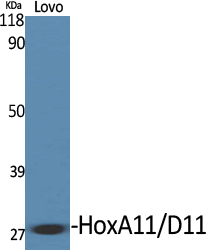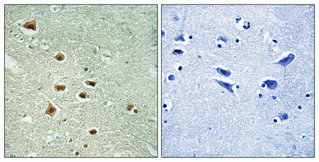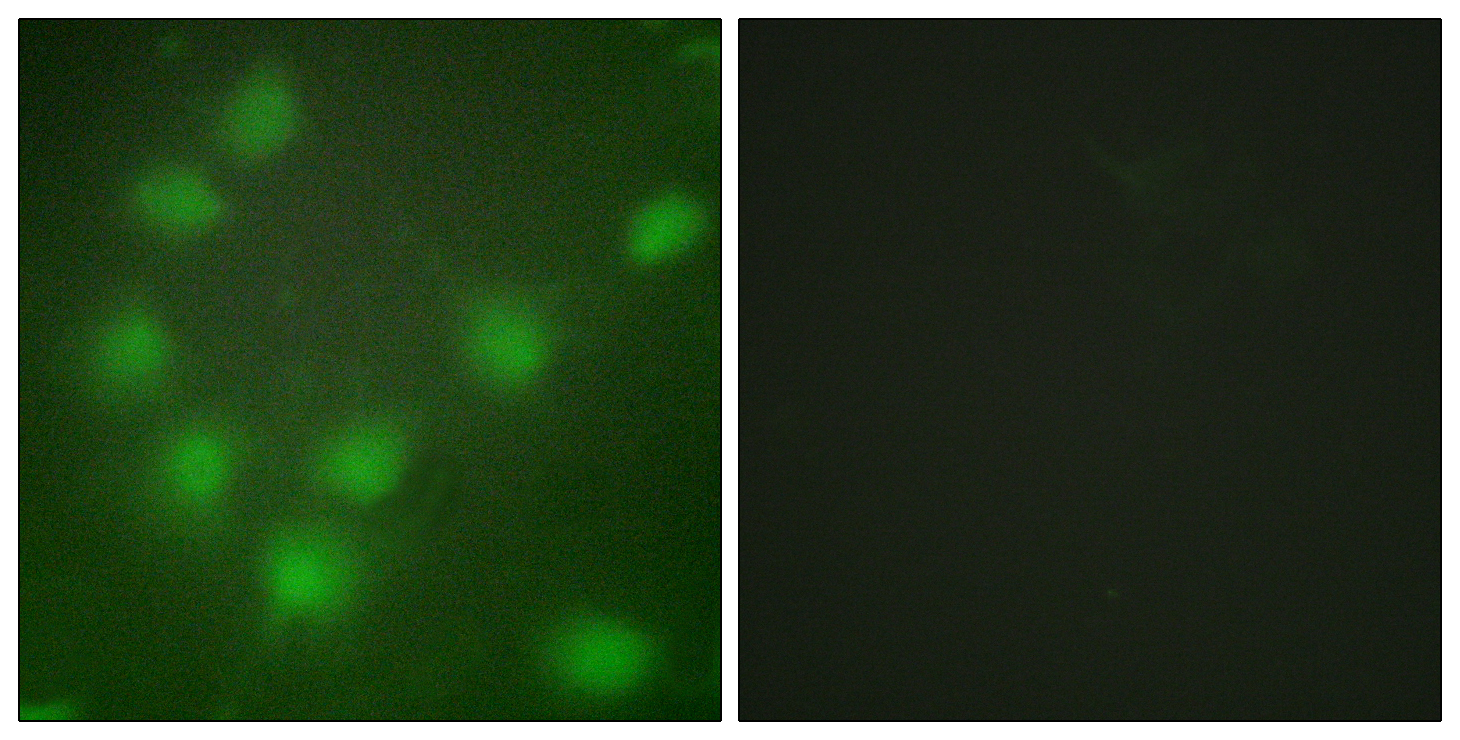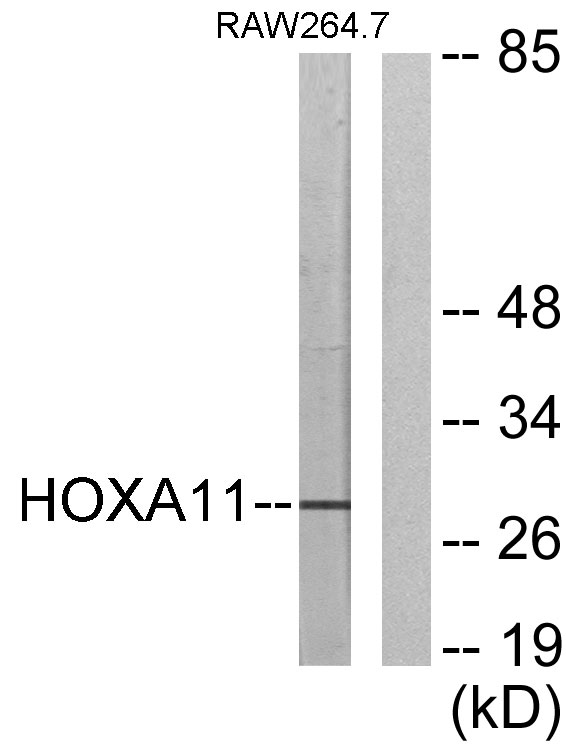HoxA11/D11 Polyclonal Antibody
- Catalog No.:YT2210
- Applications:WB;IHC;IF;ELISA
- Reactivity:Human;Mouse
- Target:
- HoxA11/D11
- Fields:
- >>Transcriptional misregulation in cancer
- Gene Name:
- HOXA11/HOXD11
- Protein Name:
- Homeobox protein Hox-A11/D11
- Human Gene Id:
- 3207/3237
- Human Swiss Prot No:
- P31270/P31277
- Mouse Gene Id:
- 15396/15431
- Immunogen:
- The antiserum was produced against synthesized peptide derived from human HOXA11/D11. AA range:216-265
- Specificity:
- HoxA11/D11 Polyclonal Antibody detects endogenous levels of HoxA11/D11 protein.
- Formulation:
- Liquid in PBS containing 50% glycerol, 0.5% BSA and 0.02% sodium azide.
- Source:
- Polyclonal, Rabbit,IgG
- Dilution:
- WB 1:500 - 1:2000. IHC 1:100 - 1:300. IF 1:200 - 1:1000. ELISA: 1:20000. Not yet tested in other applications.
- Purification:
- The antibody was affinity-purified from rabbit antiserum by affinity-chromatography using epitope-specific immunogen.
- Concentration:
- 1 mg/ml
- Storage Stability:
- -15°C to -25°C/1 year(Do not lower than -25°C)
- Other Name:
- HOXA11;HOX1I;Homeobox protein Hox-A11;Homeobox protein Hox-1I;HOXD11;HOX4F;Homeobox protein Hox-D11;Homeobox protein Hox-4F
- Observed Band(KD):
- 28kD
- Background:
- In vertebrates, the genes encoding the class of transcription factors called homeobox genes are found in clusters named A, B, C, and D on four separate chromosomes. Expression of these proteins is spatially and temporally regulated during embryonic development. This gene is part of the A cluster on chromosome 7 and encodes a DNA-binding transcription factor which may regulate gene expression, morphogenesis, and differentiation. This gene is involved in the regulation of uterine development and is required for female fertility. Mutations in this gene can cause radio-ulnar synostosis with amegakaryocytic thrombocytopenia. [provided by RefSeq, Jul 2008],
- Function:
- disease:Defects in HOXA11 are the cause of radioulnar synostosis with amegakaryocytic thrombocytopenia [MIM:605432]. The syndrome consists of an unusual association of bone marrow failure and skeletal defects. Patients have the same skeletal defects, the proximal fusion of the radius and ulna, resulting in extremely limited pronation and supination of the forearm. Some patients have also symptomatic thrombocytopenia, with bruising and bleeding problems since birth, necessitating correction by bone marrow or umbilical-cord stem-cell transplantation.,function:Sequence-specific transcription factor which is part of a developmental regulatory system that provides cells with specific positional identities on the anterior-posterior axis.,similarity:Belongs to the Abd-B homeobox family.,similarity:Contains 1 homeobox DNA-binding domain.,
- Subcellular Location:
- Nucleus.
- Expression:
- Ovary,
- June 19-2018
- WESTERN IMMUNOBLOTTING PROTOCOL
- June 19-2018
- IMMUNOHISTOCHEMISTRY-PARAFFIN PROTOCOL
- June 19-2018
- IMMUNOFLUORESCENCE PROTOCOL
- September 08-2020
- FLOW-CYTOMEYRT-PROTOCOL
- May 20-2022
- Cell-Based ELISA│解您多样本WB检测之困扰
- July 13-2018
- CELL-BASED-ELISA-PROTOCOL-FOR-ACETYL-PROTEIN
- July 13-2018
- CELL-BASED-ELISA-PROTOCOL-FOR-PHOSPHO-PROTEIN
- July 13-2018
- Antibody-FAQs
- Products Images

- Western Blot analysis of various cells using HoxA11/D11 Polyclonal Antibody diluted at 1:500 cells nucleus extracted by Minute TM Cytoplasmic and Nuclear Fractionation kit (SC-003,Inventbiotech,MN,USA).
.jpg)
- Western Blot analysis of 293T-UV cells using HoxA11/D11 Polyclonal Antibody diluted at 1:500 cells nucleus extracted by Minute TM Cytoplasmic and Nuclear Fractionation kit (SC-003,Inventbiotech,MN,USA).

- Immunohistochemical analysis of paraffin-embedded Human brain. Antibody was diluted at 1:100(4° overnight). High-pressure and temperature Tris-EDTA,pH8.0 was used for antigen retrieval. Negetive contrl (right) obtaned from antibody was pre-absorbed by immunogen peptide.

- Immunofluorescence analysis of HUVEC cells, using HOXA11/D11 Antibody. The picture on the right is blocked with the synthesized peptide.

- Western blot analysis of lysates from RAW264.7 cells, using HOXA11/D11 Antibody. The lane on the right is blocked with the synthesized peptide.



